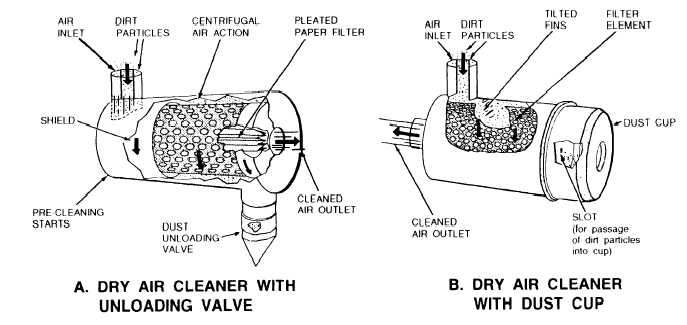Figure 1-36.-Dry-element air cleaner.
demand for air is small. The dry air cleaner cleans the
air by passing it through layers of cloth or felt that
removes large dirt particles from the air very effectively.
Dry-Element Air Cleaners
The two most common dry-element air cleaners
used are the cleaner with an unloading valve and a
cleaner with a dust cup (fig. 1-36).
Dry air cleaners are built for two-stage cleaning:
pre-cleaning and filtering. The cleaner with the dust
unloading valve, as shown in figure 1-36, view A,
directs the air into the pre-cleaner so that it strikes one
side of the metal shield. This starts the centrifugal
suction that continues until it reaches the far end of the
cleaner housing. At this point, the dirt is collected into
the dust unloader valve located at the bottom of the
housing.
The dust unloader valve is a rubber duck-bill device
that is held closed by engine suction while the engine is
running. When the engine is shut down, the weight of
the accumulated dirt helps open the flaps so the dirt can
drop out. The cleaner with the dust air cup, as shown in
figure 1-36, view B, pulls in the air past tilted fins that
starts the centrifugal suction. When the air reaches the
end of the cleaner housing, the dirt passes through a slot
in the top of the cleaner and enters the dust cup.
Both types of pre-cleaners remove over 80 percent
of the dirt particles, greatly reducing the load on the
filters. After the air goes through the pre-cleaning stage,
it then passes through the holes in the metal jacket
surrounding the pleated-paper filter. Filtering is
performed as the air passes through the paper filter that
filters out almost all of the remaining small particles.
Checking and cleaning air cleaners equipped with
either a dust unloading valve or dust cup is part of the
daily prestart and post-operational checks and
maintenance performed by the operator. The dust
unloading valve should be inspected for cracks,
clogging, and deterioration. The dust cup should be
removed and wiped clean with a rag. Dusty filter
elements should be removed and cleaned by tapping and
rotating the filter on the heel of your hand to remove the
dust.
NOTE: Do not tap the filter on a hard surface; this
can damage the element.
When the tapping does not remove the dust, use a
compressed air cleaning gun to clean the filter
(fig. 1-37). Direct the clean dry air up and down the
pleats, blowing from inside to outside.
NOTE: To prevent rupturing the filter, you must not
allow the compressed air pressure to exceed 30 psi.
To clean with water, you first blow out the dirt with
compressed air, then flush the remainder of the dirt from
inside to outside with water. After flushing is completed,
allow the filter to dry.
1-26


